|
|
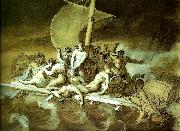 |
charles emile callande
|
|
1797-183
Charles-Emile-Callande de Champmartin (Bourges, 1797 -Paris,1883) was a French painter.
His numerous portraits, historical and religious pictures were very popular. |
|
|
|
 |
Charles Ferdinand Wimar
|
|
German-born American Painter
b.1828 d.1862
was a painter of Western Native Americans and buffaloes. Born in Siegenburg, Germany, came to America at the age of 15, settled with his parents in St. Louis, Missouri. In 1846 he began studying painting with Leon Pomarede and went with his master on a trip up the Mississippi River. In 1852 he went to the D??sseldorf Academy to study with Emanuel Leutze. Wimar returned to St. Louis in 1856. He primarily occupied himself with the themes of Indian life, buffalo herds, life in the Great Plains, the theme of the wagon trains. He made three trips to the headwaters of the Mississippi. |
|
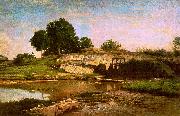 |
Charles Francois Daubigny
|
|
b Feb. 15, 1817, Paris, France
d.Feb. 19, 1878, Paris French
78, French landscape painter. He went to Italy early in life and later studied in Paris with Paul Delaroche. Although usually classed with the Barbizon school, he never lived in Barbizon. His last 30 years were spent largely in his houseboat on the Seine and the Oise, and he is best known for his pictures of the banks of those rivers. He was particularly successful in his atmospheric depiction of dawn, twilight, and moonlight. His later pictures are handled with great breadth. Monet and Boudin were especially attentive to his work. Daubigny is well represented in the Louvre, the Mesdag Museum (The Hague), the National Gallery (London), and the Metropolitan Museum. Characteristic are his Return of the Flock??Moonlight, Banks of the Oise, and Moonlight. His son Karl Pierre Daubigny, 1846?C86, painted in his father manner. |
|
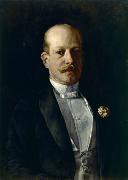 |
Charles Frederic Ulrich
|
|
Charles Frederic Ulrich (1858, New York City - 1908, Berlin), was an American painter.
According to the RKD he worked in the Netherlands ca. 1890. He attended the Royal Academy in Munich, Germany, as did William Merritt Chase, who like him, was influenced by Dutch Golden Age painting and who has been documented as painting his portrait. He was discovered by Thomas B. Clarke, a lace and linen manufacturer in New York who became a collector of contemporary American art. Ulrich painted his portrait in gratitude after his painting "In the Land of Promise, Castle Garden" was shown at the National Academy of Design, where it won the National Academy's first Thomas B. Clarke Prize for Best American Figure Composition. |
|
|
|
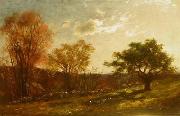 |
Charles Furneaux
|
|
(1835 - 1913) was born in Boston and became a drawing instructor in that area. For many years he lived in the town of Melrose, Massachusetts. In 1880, Furneaux moved to Hawaii, where he cultivated the friendship King Kalakaua and other members of the Hawaiian royal family, from whom he later received several commissions. In the late 1880's,he was commissioned in Honolulu by Alexander Joy Cartwright, widely credited as the "father of baseball" and another dear friend of King Kalakaua, to paint the only oil portrait of his 72 year life. While living in Honolulu he taught at the private schools Punahou and St. Albans (now known as Iolani School). In 1885, he received the order of Chevalier of Kapiolani from King Kalakaua in 'recognition of his services in advancing Hawaiian art'. He died in Hawaii in 1913.
His reputation is mainly based on the paintings he executed in Hawaii, especially those of erupting volcanoes. The Bishop Museum (Honolulu), the Brooklyn Museum, the Honolulu Academy of Arts, Iolani Palace (Honolulu) and Mount Holyoke College Art Museum (South Hadley, Massachusetts) are among the public collections holding works by Charles Furneaux.
|
|
|
|
|
|
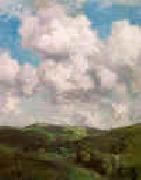 |
Charles Harold Davis
|
|
1856-1933
He was born at Amesbury, Massachusetts. A pupil of the schools of the Boston Museum of Fine Arts, he was sent to Paris in 1880. Having studied at the Acad??mie Julian under Jules Joseph Lefebvre and Gustave Boulanger, he went to Barbizon and painted much in the forest of Fontainebleau under the traditions of the men of thirty.
In 1890, Davis returned to the U.S., settling in Mystic, Connecticut. He shifted to Impressionism in his style, and took up the cloudscapes for which he became best-known. He eventually became a leading figure in the art colony that had developed in Mystic, and founded the Mystic Art Association in 1913.
He became a full member of the National Academy of Design in 1906, and received many awards, including a silver medal at the Paris Exhibition of 1889.
He is represented by important works in the Metropolitan Museum of Art, New York; the Corcoran Gallery of Art, Washington; the Pennsylvania Academy, Philadelphia, and the Boston Museum of Fine Arts. |
|
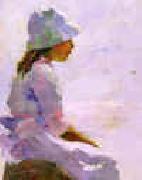 |
Charles Hawthorne
|
|
1872-1930
Charles Webster Hawthorne (January 8, 1872 ?C November 29, 1930) was an American portrait and genre painter and a noted teacher who founded the Cape Cod School of Art in 1899.
He was born in Maine, started as an office-boy in a stained-glass factory in New York, studied at night school and with Henry Siddons Mowbray and William Merritt Chase, and abroad in both Holland and Italy.
When he was eighteen, Hawthorne went to New York and studied painting at the National Academy of Design and the Art Students League. Among his teachers were Frank Vincent DuMond and George de Forest Brush. But Hawthorne declared that the most dominant influence in his career was William Merritt Chase, with whom he worked as both a pupil and assistant. Both men were naturally talented teachers and figurative painters who were drawn to rich color and the lusciousness of oil paint as a medium. Chase passed on a Munich tradition of tone values and tone painting, and Hawthorne learned all he could.
While studying abroad in Holland as Chase's assistant, Hawthorne was influenced to start his own school of art.
His winters were spent in Paris and New York City, his summers at Provincetown, Massachusetts, the site of his school. While in Paris Hawthorne became a full member of the French Soci??t?? Nationale des Beaux-Arts in 1917. |
|
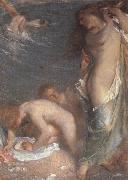 |
Charles Hazelwood Shannon
|
|
English painter, printmaker and collector , 1863-1937
English artist, was born at Sleaford in Lincolnshire, the son of the Rev. Frederic Shannon. He attended the City and Guilds of London Art School (then known as South London School of Technical Art, formerly Lambeth School of Art), and was subsequently considerably influenced by his lifetime partner Charles Ricketts[2] and by the example of the great Venetians. In his early work he was addicted to a heavy low tone, which he abandoned subsequently for dearer and more transparent colour. He achieved great success with his portraits and his Giorgionesque figure compositions, which are marked by a classic sense of style, and with his etchings and lithographic designs. The Dublin Municipal Gallery owns his circular composition "The Bunch of Grapes" and "The Lady with the Green Fan" (portrait of Mrs Hacon). His "Study in Grey" is at the Munich Gallery, a "Portrait of Mr Staats Forbes" at Bremen, and a "Souvenir of Van Dyck" at Melbourne. One of his most remarkable pictures is "The Toilet of Venus" in the collection of Lord Northcliffe. Several of his portrait works are on display in the National Portrait Gallery in London. Complete sets of his lithographs and etchings have been acquired by the British Museum and the Berlin and Dresden print rooms. He was awarded a first-class gold medal at Munich in 1895 and a first-class silver medal in Paris in 1900. |
|
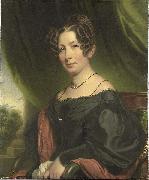 |
Charles Howard Hodges
|
|
(1764, Portsmouth - July 24, Amsterdam), was a British painter active in the Netherlands during the French occupation of 18th and early 19th century.
Charles Howard Hodges had visited Amsterdam in 1788; after a two-year stay in Dublin, he moved with his family to The Hague in 1792. In Amsterdam, he worked as an artist, specialized in the mezzotint technique and pastel. In 1797, he and his family moved to Amsterdam, where he lived with his teacher Johann Friedrich August Tischbein at the Prinsengracht Ne 205. There, he became a famous painter of portraits; he painted over 700 portraits of the rich and famous of that time. He was also an engraver, printer, art dealer and a member of the Amsterdam art club Felix Meritis.
He is well-known for the fact that he painted all the leaders of the Netherlands during the Napoleonic Period, -a turbulent period in Dutch history, since the Netherlands went through 5 different political systems: stadtholder Willem V of the Republic of the United Netherlands, Grand Pensionary Rutger Jan Schimmelpenninck of the Batavian Republic, King Louis Bonaparte (King of Holland), Emperor Napoleon Bonaparte and king William I of the Netherlands. The only known portrait of Sebald Justinus Brugmans was made by him. A design for the honorary cross of the Order of the Union was rejected by Louis Bonaparte.
Hodges advised the Dutch government in 1815 with the return of thousands of works of art, which were confiscated by the French in 1795 from several collections, including the Gallery of Prince William V (the first museum open to the public in the Netherlands), and the several collections of the previous stadtholders. Not all the stolen art was returned from Paris, and it is said that several pieces are still held in the Louvre up to this day.
Most of the over 700 portraits by Hodges are made in the early 19th century, the earlier works in pastel, and later work in oil paint. Several of these portraits can be found in the Rijksmuseum in Amsterdam, in museums and castles and in royal and private collections.
Charles Howard Hodges was father and teacher to James Newman Hodges, een lesser painter who worked in the Rijksmuseum when it was still located in the Trippenhuis in Amsterdam.
|
|
|
|
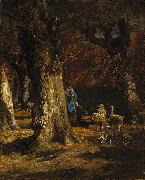 |
Charles Jacque
|
|
(23 May 1813 - 7 May 1894) was a French painter of animals (animalier) and engraver who was, with Jean-François Millet, part of the Barbizon School. He first learned to engrave maps when he spent seven years in the French Army.
Fleeing the Cholera epidemics that besieged Paris in the mid-nineteenth century, Charles Jacque relocated to Barbizon in 1849 with Millet. There, he painted rustic or pastoral subject matter: shepherds, flocks of sheep, pigs, and scenes of farm life. In addition to painting, Jacque was also famous for his etchings and engravings. He, along with Felix Bracquemond and Felix Buhot, is credited with the nineteenth-century revival of seventeenth-century techniques. He began his career as an engraver around 1841 by publishing a series of etchings with Louis Marvy. He followed this work with a serious of engravings based on the works of Adriaen van Ostade, after which he began to create original engravings / artworks. Charles Baudelaire said of him, "Mr. Jacque new reputation will continue to grow always, we hope. His etchings are very bold and his subject matter is well conceived. All that Mr. Jacque does on copper is filled with a freedom and a frankness which reminds one of the Old Masters. |
|
|
|
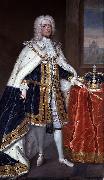 |
Charles Jervas
|
|
Charles Jervas (c. 1675 - 1739) was an Irish portrait painter, translator, and art collector of the early 18th century.
Born in County Offaly,Ireland around 1675, the son of John Jervas and Elizabeth, daughter of Captain John Baldwin of Shinrone Castle & Corolanty, High Sheriff of County Offaly. Jervas studied in London, England as an assistant under Sir Godfrey Kneller between 1694 and 1695.
After selling a series of small copies of the Raphael Cartoons circa 1698 to Dr. George Clarke of All Souls College, Oxford, the following year he travelled to Paris and Rome (while financially supported by Clarke and others) remaining there for most of the decade before returning to London in 1709 where he found success as a portrait painter. |
|
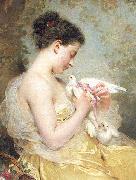 |
Charles Joshua Chaplin
|
|
(8 June 1825 - 30 January 1891) was a French painter and engraver. He was born in Les Andelys, Eure, France to an English father and a French mother. Although he spent the whole of his life in France, he only became naturalized in 1886. He died in Paris, France.
Chaplin conducted art classes specifically for women at his studio. The American artist Mary Cassatt and the English artist Louise Jopling were among Chaplin's students. |
|
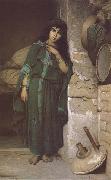 |
Charles Landelle
|
|
1812-1908
French painter. His father, a calligrapher and musician from Mayenne, moved to Paris in 1825 to take up a post as musician in the Tuileries. Ary Scheffer, whom Landelle met through his father's contact with the Orleans court, encouraged him to become a painter. He registered at the Ecole des Beaux-Arts on 2 October 1837 as a pupil of Paul Delaroche and made his debut at the Salon in 1841 with a Self-portrait (Laval, Mus. Vieux-Cheteau). His first success, Fra Angelico asking God for Inspiration , indicated a sentimental, religious tendency in his work, which alternated with pretty pictures of young girls. Charity. commissioned by Antoine Vivenel (1799-1862), was followed by Idyll and Elegy (untraced), which were bought by the dealer Adolphe Goupil on the opening day of the 1844 Salon. The contract to buy also included Goupil's right of first refusal on the reproduction of all Landelle's future work. Subsequently, he painted the Three Marys at the Tomb in the pious manner of Ary Scheffer and a sweet, angelic St Cecilia, commissioned in 1845 by the Prefect of the Seine, in which elements of the early Renaissance art seen by Landelle on a trip to Italy in 1845 combined with the soft, pale style common among some of his colleagues from the studio of Delaroche. He also painted religious works for St Roch (1850), St Germain l'Auxerrois (1856) and St Sulpice (1875) churches in Paris. |
|
|
|
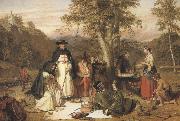 |
Charles landseer,R.A.
|
|
1799-1879
Painter, brother of Thomas Landseer. He trained initially with his father John Landseer, then under Benjamin Robert Haydon, and in 1816 he attended the Royal Academy Schools in London. In 1823 he accompanied Sir Charles Stuart de Rothesay (1779-1845) aboard HMS Wellesley on a voyage to Portugal and then to Brazil, in order to negotiate a commercial treaty with Pedro I, Emperor of Brazil (reg 1822-31). Many of the drawings he made on this trip were exhibited in 1828 at the British Institution, and in that year he sent his first painting to the Royal Academy. This was Dorothea, illustrating a scene from Cervantes's Don Quixote. He continued to exhibit at the Academy until his death, showing mostly romanticized history paintings or such literary subjects as Clarissa Harlowe in the Sponging House from Samuel Richardson's novel Clarissa (London, 1748). The English Civil War (1642-51) was of particular interest to him, his devotion to such historical subjects perhaps being attributable to the influence of his years with Haydon. He also painted portraits, genre scenes and animal studies . In 1837 he was elected ARA and in 1845 RA. In 1851, probably due to the influence of his brother Edwin, he succeeded George Jones as Keeper of the Royal Academy Schools. Responsible for instructing the antique class, his tenure was criticized both for the way his position had been obtained and for the deficiency of his teaching, and he retired from the Keepership in 1873 on full salary. |
|
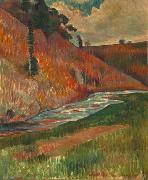 |
Charles Laval
|
|
(1862-1894) was a French painter born March 17, 1862 in Paris and who died April 27, 1894. He is associated with the Synthetic movement and Pont-Aven School, and he was a contemporary and friend of Paul Gauguin and Vincent van Gogh. Gauguin created a portrait of him in 1886 looking at one of Gauguin's Ceramic sculptures, entitled "Still Life with Profile of Laval".
Paul Gauguin and Laval both came to Pension Gloanec in Pont-Aven in 1886 and became friends. In search of an exoticism that could provide the key to art, Gauguin and Laval went to Panama in 1887. To gain some subsidies, Laval performs academic portraits (all lost), using his experience received from Leon Bonnat. A series of mishaps caused Laval and Gauguin to leave the Central America for the island of Martinique. |
|
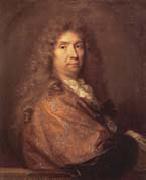 |
Charles le Brun
|
|
French Baroque Era Painter, 1619-1690
French painter and designer. He dominated 17th-century French painting as no other artist; it was not until over a century later, during the predominance of Jacques-Louis David, that artistic authority was again so concentrated in one man. Under the protection of a succession of important political figures, including Chancellor Pierre S?guier, Cardinal Richelieu and Nicolas Fouquet, Le Brun created a series of masterpieces of history and religious painting. For Louis XIV and his chief minister Jean-Baptiste Colbert he executed his greatest work, the royal palace of Versailles: an almost perfect ensemble of architecture, decoration and landscape. After Colbert's death in 1683, he was no longer able to count on prestigious commissions |
|
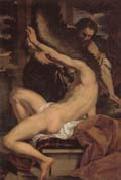 |
Charles Lebrun
|
|
French Pand art Theorist ,
Paris1619-190
Virtual dictator of the arts in France until the death of Colbert in 1683. He established his reputation by a series of decorative schemes, and his own greatest compositions, which immortalize the achievements of the crown, are at Versailles. He became a founder, rector, chancellor, and finally director of the Academie Royale de Peinture et de Sculpture. He was also director of the Gobelins factory and Premier Peintre (1664). His Tent of Darius (1661), for Louis XIV, is a model of legibility, with the explicit and varied gesture and expression of the figures deriving from ideas expressed by Poussin. Lebrun's influential treatise, |
|
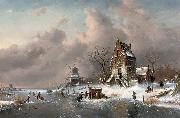 |
Charles Leickert
|
|
22 September 1816, Brussels - 5 December 1907, Mainz was a Belgian painter of Dutch landscapes.
Orphan Leickert first learned painting in The Hague under the supervision of landscape painters Bartholomeus van Hove, Wijnand Nuijen, and Andreas Schelfhout among many others. Leickert specialised in winter scenes, sometimes romanticising the sky in pale blues and bright pinks. He painted almost all his works in the Netherlands, from 1841-1848 in The Hague and from 1849-1883 in Amsterdam. In 1856, he became a member of the Royal Academy of Amsterdam. At the age of 71 he moved to Mainz, Germany where he later died in 1907.
|
|
|
|
|
|
|
|
|
|
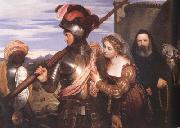 |
Charles Lock Eastlake
|
|
English Painter, 1793-1865
English painter, museum director, collector and writer. Fourth son of an Admiralty lawyer at Plymouth, he was educated at local grammar schools and then, briefly, at Charterhouse, Surrey. Determined to become a painter, he began work in 1809 as Benjamin Robert Haydon's first pupil and as a student at the Royal Academy Schools in London. In 1815 he exhibited for the first time at the British Institution, visited Paris and studied the pictures in the Musee Napoleon. He achieved his first conspicuous success with a scene from contemporary history that he had himself witnessed, |
|
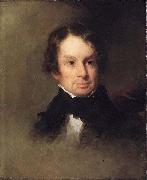 |
Charles Loring Elliott
|
|
1812-1868.
Elliott was born at Auburn, New York in the central part of the state. He began working as a painter in his region. After 10 years, he moved to New York City to study art under the painters John Trumbull and John Quidor, as well as to be in a bigger market for work.
After practicing portrait painting in central New York State for 10 years, Elliott took up residence in New York City in 1845. The following year he was elected to the National Academy of Design, which was a measure of recognition and helped him attract more clients.
Painting by Elliott of Samuel Putnam Avery, 1863Elliott was considered the best portraitist of his day. Although he never studied abroad, his technique is neither provincial nor uncertain. His method is mature, his drawing firm, his color fresh and clean, and his likenesses excellent, though somewhat lacking in sentiment.[citation needed] He was said to have painted over 700 portraits, mostly heads, as he had little idea of the composition of large canvases. He also painted figure pieces, including Don Quijote and Falstaff, and one landscape, The Head of Skaneateles Lake. |
|
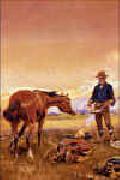 |
Charles M Russell
|
|
American Painter, 1864-1926
American painter and sculptor. In 1880 he left his upper-class home in St Louis for Montana Territory. He worked briefly on a sheep ranch, spent two years as a hunter's and trapper's assistant and then became a cowboy. During his considerable spare daytime hours he painted, sketched and modelled small animal figures in clay (e.g. Antelope, 1915; Fort Worth, TX, Amon Carter Mus.). Although he painted a few exceptional oils and watercolours prior to 1900, the vast majority of his best work was done in the last two decades of his life. Typically the subject-matter centres around cowboy life (e.g. Wagon Boss, 1909; Tulsa, OK, Gilcrease Inst. Amer. Hist. & A.) and the Plains Indians, for whom he had great respect. The luminous Piegans (1918; Denver, CO, Mus. W. A.), with its depiction of the Plains Indians, is a reminder of the vastness of the American West. Russell's sense of humour and empathy for his subject-matter radiates from his paintings as pleasingly as do the clear colours of the high country. His bronze sculptures (e.g. Buffalo Hunt, 1905; Denver, CO, Mus. W. A.) depict the same dramatic and tension-packed themes as his paintings. |
|
|
|
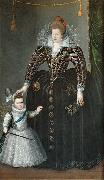 |
Charles Martin
|
|
Charles Martin (1884-1934) was a French artist and illustrator. |
|
|
|
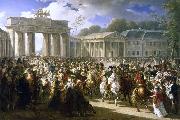 |
Charles Meynier
|
|
Charles Meynier (1763, Paris - 1832, Paris) was a French painter. A student of François-Andre Vincent, Meynier won the second prize in the 1789 prix de Rome competition. He made designs for the bas-reliefs and statues on the Arc de Triomphe du Carrousel and was, from 1816 onward, a member of the Academie des Beaux-Arts
|
|
|
|
 |
Charles Napier Hemy
|
|
English Painter, 1841-1917, British painter, He was born at Newcastle-on-Tyne, of a musical family. He was trained in the Government School if Design, Newcastle, in the Antwerp academy and in the studio of Baron Leys. He returned to London in the 1870s. In 1881, he moved to Falmouth, Cornwall. He produced some figure subjects and landscapes, but is best known by his marine paintings. He was elected an Associate of the Royal Academy in 1898 and an Academician in 1910, Associate of the Royal Society of Painters in Water Colours in 1890 and member in 1897. Two of his paintings, "Pilchards" (1897) and "London River" (1904), are in the Tate collections. He had two brothers who were also artists, Thomas Hemy and Bernard Hemy. He died in Falmouth on September 30, 1917. |
|
|
|
|
|
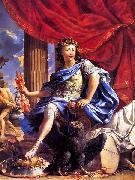 |
Charles Poerson
|
|
French Painter, 1609-1667
He studied under his own father Charles Poerson (himself a former pupil of Simon Vouet) and under Noël Coypel. His notable works include "Dispute Between Neptune and Minerva" at Chateau de Fontainebleau, "Union of the Academie royale de Paris and the Academy of Saint Luke in Rome" at Versailles and participation in the decoration of the Hotel des Invalides. He was buried in San Luigi dei Francesi, Rome, in a tomb attributed to the sculptor Pierre de L'Estache, who later became another director of the Academy. |
|
|
|
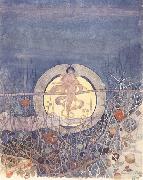 |
Charles Rennie Macintosh
|
|
Scottish Art Nouveau Designer , (1868-1928).
Scottish architect, designer and painter. In the pantheon of heroes of the Modern Movement, he has been elevated to a cult figure, such that the importance of his late 19th-century background and training in Glasgow are often overlooked. He studied during a period of great artistic activity in the city that produced the distinctive GLASGOW STYLE. As a follower of A. W. N. Pugin and John Ruskin, he believed in the superiority of Gothic over Classical architecture and by implication that moral integrity in architecture could be achieved only through revealed construction. Although Mackintosh's buildings refrain from overt classicism, they reflect its inherent discipline. His profound originality was evident by 1895, when he began the designs for the Glasgow School of Art. His decorative schemes, particularly the furniture, also formed an essential element in his buildings. During Mackintosh's lifetime his influence was chiefly felt in Austria, in the work of such painters as Gustav Klimt and such architects as Josef Hoffmann and Joseph Maria Olbrich. The revival of interest in his work was initiated by the publication of monographs by Pevsner (1950) and Howarth (1952). The Charles Rennie Mackintosh Society was formed in Glasgow in 1973; it publishes a biannual newsletter, has a reference library and organizes exhibitions. The Hunterian Art Gallery, University of Glasgow, which opened in 1981, |
|
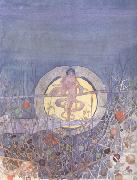 |
Charles Rennie Mackintosh
|
|
Scottish Art Nouveau Designer, 1868-1928
Scottish architect, designer and painter. In the pantheon of heroes of the Modern Movement, he has been elevated to a cult figure, such that the importance of his late 19th-century background and training in Glasgow are often overlooked. He studied during a period of great artistic activity in the city that produced the distinctive GLASGOW STYLE. As a follower of A. W. N. Pugin and John Ruskin, he believed in the superiority of Gothic over Classical architecture and by implication that moral integrity in architecture could be achieved only through revealed construction. Although Mackintosh's buildings refrain from overt classicism, they reflect its inherent discipline. His profound originality was evident by 1895, when he began the designs for the Glasgow School of Art. His decorative schemes, particularly the furniture, also formed an essential element in his buildings. During Mackintosh's lifetime his influence was chiefly felt in Austria, in the work of such painters as Gustav Klimt and such architects as Josef Hoffmann and Joseph Maria Olbrich. The revival of interest in his work was initiated by the publication of monographs by Pevsner (1950) and Howarth (1952). The Charles Rennie Mackintosh Society was formed in Glasgow in 1973; it publishes a biannual newsletter, has a reference library and organizes exhibitions. |
|
 |
Charles Ricketts
|
|
1866-1931
English painter, designer, writer and collector. He trained as an illustrator at the City and Guilds Technical Art School, Lambeth, London, where he met and formed a lifelong relationship with CHARLES HAZELWOOD SHANNON. He identified with the ideals of the Aesthetic Movement, finding inspiration in Renaissance art as well as in the French artists Gustave Moreau and Pierre Puvis de Chavannes. In 1888 he took over James Abbott McNeill Whistler's house, The Vale, in Chelsea and drew together an artists' colony. Inspired by the work of A. H. Mackmurdo and William Morris, he set up a small press over which he exercised complete control of design and production, producing art journals and books that included Oscar Wilde's A House of Pomegranates (1891) and The Sphinx (1894). Ricketts later designed founts, initials, borders and illustrations for the Vale Press (1896-1904), blending medieval, Renaissance and contemporary imagery. |
|
 |
Charles Robert Leslie
|
|
1794 - 1859
was born in London on 19 October 1794. His parents were American, and when he was five years of age he returned with them to their native country. They settled in Philadelphia, where their son was educated and afterwards apprenticed to a bookseller. He was, however, mainly interested in painting and the drama, and when George Frederick Cooke visited the city he executed a portrait of the actor from recollection of him on the stage, which was considered a work of such promise that a fund was raised to enable the young artist to study in Europe. He left for London in 1811, bearing introductions which procured for him the friendship of West, Beechey, Allston, Coleridge and Washington Irving, and was admitted as a student of the Royal Academy, where he carried off two silver medals. At first, influenced by West and Fuseli, he essayed high art, and his earliest important subject depicted Saul and the Witch of Endor; but he soon discovered his true aptitude and became a painter of cabinet-pictures, dealing, not like those of David Wilkie, with the contemporary life that surrounded him, but with scenes from the great masters of fiction, from Shakespeare and Cervantes, Addison and Moli??re, Swift, Sterne, Fielding and Smollett. Of individual paintings we may specify Sir Roger de Coverley going to Church (1819); May-day in the Time of Queen Elizabeth (1821); Sancho Panza and the Duchess (1824); Uncle Toby and the Widow Wadman (1831); La Malade Imaginaire, act iii. sc. 6 (1843); and the Dukes Chaplain Enraged leaving the Table, from Don Quixote (1849). Many of his more important subjects exist in varying replicas. He possessed a sympathetic imagination, which enabled him to enter freely into the spirit of the author whom he illustrated, a delicate perception for female beauty, an unfailing eye for character and its outward manifestation in face and figure, and a genial and sunny sense of humour, guided by an instinctive refinement which prevented it from overstepping the bounds of good taste. In 1821 Leslie was elected A.R.A., and five years later full academician. In 1833 he left for America to become teacher of drawing in the military academy at West Point, but the post proved an irksome one, and in some six months he returned to England. |
|
|
|
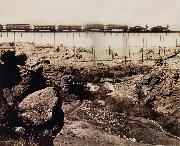 |
Charles Roscoe Savage
|
|
1832-1909, He was a British-born landscape and portrait photographer who produced images of the American West. He is best known for his 1869 photographs of the linking of the first transcontinental railroad. Savage was born in Southampton, England, on August 16, 1832. At age 14, he joined The Church of Jesus Christ of Latter-day Saints (LDS Church). After serving missions for the church in Switzerland and England, he emigrated to the United States during the winter of 1855?C56. He initially found work as a photographer in New York City, and headed west the following year. He first settled in Nebraska, then Council Bluffs, Iowa, where he established his first independent studio and gallery. In the spring of 1860, he traveled to Salt Lake City, Utah Territory with his family, where he established a photography studio with a partner, Marsena Cannon, an early Utah daguerreotypist and photographer. A year later, after Cannon moved to southern Utah, Savage established a partnership with artist George Ottinger. Many of Savage's photographs were reproduced in Harper's Weekly newspaper, which created a national reputation for the firm. This partnership continued until 1870. As a photographer under contract with the Union Pacific Railroad, Savage traveled to California in 1866 and then followed the rails back to Utah. He photographed the linking of the Union Pacific and Central Pacific on Promontory Summit, at Promontory, Utah in 1869 |
|
|
|
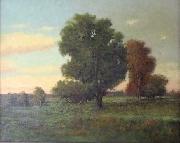 |
Charles S. Dorion
|
|
Charles was most likely born in Quebec, Canada, and moved to New York City sometime after 1880. He had a publishing company called C.S. Dorion, and was the 8th company to publish Edgar Allan Poe's the Raven, in New York in 1881.
PoliticsDuring the 1890s, Charles Dorian socialized with New York City's Social Democratic Party's elite, and used his quick tongue and self appointed crusading against injustice to help propel his friends political careers.
His first noted case was in the summer of 1893, when bucket shops were becoming a rampant problem in the city, as these "bucket shops" specializing in stocks and commodity futures, as the terms of trade were different for each bucket shop. |
|
|

